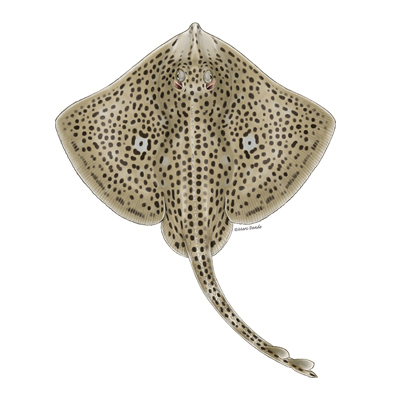

A relatively small sized ray belonging to the skate family which is often marketed as skate wings. Spotted rays have a rough upper skin and large skin teeth along its tail. The spotted ray is one of 5 similar Rajid skate species found in our waters.
Cornish boats landing to Cornish ports
Caught using monofilament nets set on the seabed
Learn moreCornish boats landing to Cornish ports
Caught using heavy beam trawl nets that are dragged over the seabed.
Learn moreCornish boats landing to Cornish ports
A large trawl held open by paravane trawl doors, the open net is then pulled along in contact with the seabed.
Learn moreCornwall Good Seafood Guide rates fish on sustainability using a scale of 1 to 5.
1, 2 and 3 are recommended, Fish to avoid are rated 5.
We use the system devised by the Marine Conservation Society (MCS) so our scores are comparable with the scores produced by MCS for the UK and fisheries from all around the world. For more information on scoring click here.
Latest advice from ICES shows that although this is a data poor stock biomass is above MSY and fishing pressure is below MSY whis is very good. Skates and rays are inherently vulnerable to overfishing due to slow growth rates, late maturation and low fecundity. In addition, little is known about the stock status of many individual species because they have been historically landed under the generic skates and rays category. Avoid eating these species below the size at which they mature: spotted ray males mature at a length of about 54cm and females at about 57cm (both between 3 to 8 years old). MMO landings data show that landings of spotted ray have increased each year to Cornish ports from 22 tonnes in 2014 to 59 tonnes in 2019. The International Conservation Union (IUCN) assessed spotted ray populations as being relatively stable in our area and to be of "Least Concern".
Skates and rays form an important component of trawl and net fisheries and are routinely landed as 'skate', rather than species specific reporting. This species is taken as bycatch and as a small and low value species they are often discarded. A study by CEFAS Catchpole et all 2009 shows that some discarded spotted ray may survive but overall discard mortality kills as many spotted rays as are landed by fishermen. No Minimum Landing Size (MLS) is specified for skates and rays in EU waters outside 6 miles. Bycatch of marine mammals and other non-target species can be problematic in fixed-net fisheries. However, use of management measures, including acoustic devices called 'pingers', can help reduce bycatch of marine mammals. See Fishing methods for more details.






Cornwall Good Seafood Guide is underpinned by the Marine Conservation Society (MCS) Good Fish Guide. The first UK consumer guide to sustainable seafood. For more information visit www.fishonline.org
Cornwall Good Seafood Guide is here to help us all make sustainable seafood choices. Choices that will help us keep the oceans healthy and Cornish fishers' futures safe. This website is funded by Cornwall Wildlife Trust. If you would like to make a meaningful difference to the health of our oceans, please consider making a donation to the Cornwall Wildlife Trust Ocean Emergency fund. Your donation will help safeguard these remarkable environments, ensuring that they continue to thrive for generations to come. Together, we can be stewards of the seas and champions for a healthier, more sustainable future.